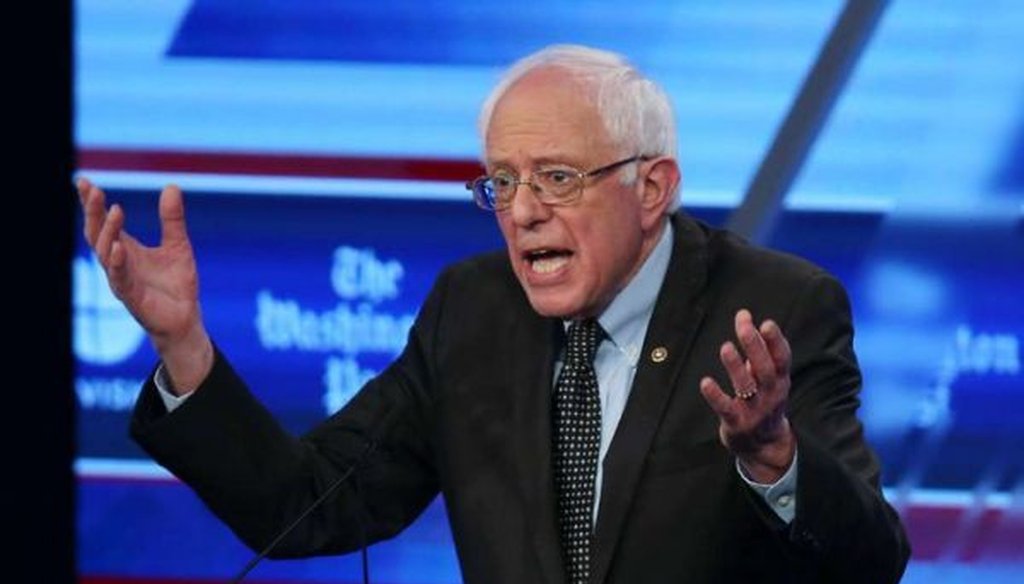

Our only agenda is to publish the truth so you can be an informed participant in democracy.
We need your help.


Democratic presidential candidate Bernie Sanders speaks at the Univision News-Washington Post debate on March 9, 2016, in Miami. (Joe Raedle/Getty Images)
During the Univision-Washington Post Democratic presidential debate in Miami, Bernie Sanders highlighted the bleak economic prospects of minority youths.
"One of the points that I've been making, and media does not seem to pick up on it, is that we have a real crisis not only with real unemployment in America being close to 10 percent, but youth unemployment in this country," Sanders said. "If you look at Latino kids between 17 and 20 who graduated high school, 36 percent of them are unemployed or underemployed. … African-American kids are unemployed or underemployed to the tune of 51 percent."
We checked a nearly identical statement by Sanders back in July 2015, when Sanders mentioned it at a campaign event in Portland, Maine. We rated it Mostly True. Now, eight months later, we’ll revisit it.
We’ll start by noting that the most commonly used unemployment-rate statistic is not as high for each group as Sanders indicated. The most readily available data from the Bureau of Labor Statistics covers the age range from 16 to 19, which isn’t identical but gives a quick approximation.
For whites in that age range, the official unemployment rate in February 2016 was 13.9 percent, for Hispanics it was 15.6 percent and for African-Americans it was 23.3 percent.
In other words, the official unemployment rate shows that African-American youth unemployment is significantly higher than white youth unemployment and, to a lesser extent, higher than Hispanic youth unemployment. Still, the levels for each group are lower than what Sanders said.
So what’s going on?
Sanders’ camp pointed us to research published in June 2015 by the Economic Policy Institute, a left-of-center think tank. The numbers in the report match what Sanders said at the debate.
This data is different from the more familiar measurements for a few reasons.
One, the institute didn’t just look at employment status for people between the ages of 17 and 20; it limited its reach to high school graduates who were not enrolled in further schooling.
And two, EPI counted not only unemployed workers but also those who were working part-time due to the weakness of the economy and those who were "marginally attached to the labor force." The latter category includes people who did not meet the strict definition of being in the job market, but weren’t entirely out of the market, either.
The statistic EPI used, known by the wonky shorthand U-6, is officially called a measure of "labor underutilization" rather than "unemployment." EPI itself used the term "underemployment" in its research.
At the Miami debate, Sanders described this statistic accurately, referring to individuals who are "unemployed or underemployed." So his statement has merit.
However, the data is getting a little stale, and since the employment picture has generally been improving since the middle of last year, that’s a potential problem for the accuracy of Sanders’ statement.
The last month analyzed in the EPI study was March 2015. We don’t know exactly how much improvement there’s been for young, minority, high school graduates since then, because that specific slice of the data isn’t readily available on the Bureau of Labor Statistics website. But we can do a quick estimate based on the change in unemployment rates for 16-to-19-year-old Hispanics and African-Americans between March 2015 and February 2016.
During that period -- since the EPI report came out -- the unemployment rate for young Hispanics fell from 20.9 percent to 15.6 percent, and for young African-Americans, it fell from 25.1 percent to 23.3 percent.
In other words, it’s quite possible that the unemployment rates for young, minority, high-school grads is lower now than what Sanders stated.
We should caution that the unemployment rate for subsets of the population, such as minority groups, tends to be volatile and has a larger margin of error than for the population as a whole.
Still, the unemployment rates for these groups do seem to be lower in more recent months.
During 2015, the black youth unemployment rate often reached or exceeded 30 percent, making the current rate of 23.3 percent particularly low -- the lowest since 2000, in fact. Similarly, in 2015, the Hispanic youth unemployment rate often reached or exceeded 20 percent, a level well above the current 15.6 percent rate.
Our ruling
Sanders said that "if you look at Latino kids between 17 and 20 who graduated high school, 36 percent of them are unemployed or underemployed. … African-American kids are unemployed or underemployed to the tune of 51 percent."
As was the case when we first reviewed this claim last July, Sanders’ general point is correct -- that in an apples-to-apples comparison, African-American and Hispanic youth have significantly worse prospects in the job market than whites do.
But while Sanders had support for this data when he first began using these numbers eight months ago, there’s reason to believe that the improving job market has lowered these rates, at least somewhat. The statement is accurate but needs clarification or additional information, so we rate it Mostly True.
Bernie Sanders, comments during a Democratic presidential debate in Miami, March 9, 2016
Economic Policy Institute, "Young Black High School Grads Face Astonishing Underemployment," June 8, 2015
Bureau of Labor Statistics, "Labor Force Statistics from the Current Population Survey" (main index page), March 9, 2016
PolitiFact, "Bernie Sanders says 'real unemployment' rate for African American youth is 51 percent," July 13, 2015
In a world of wild talk and fake news, help us stand up for the facts.
